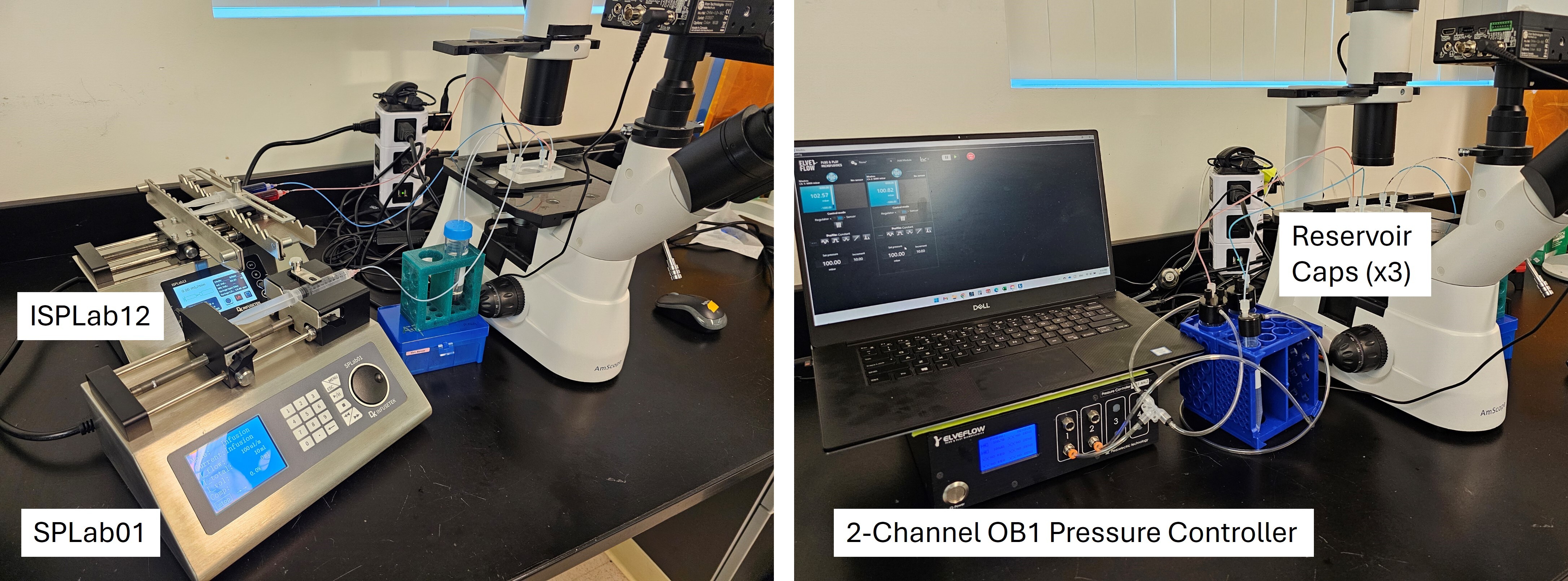Review: Syringe Pump vs Pressure Controller for Microfluidic Droplet Generation
Published by Alex Hwu & Ehsan Shamloo on Mar 26th 2025
Microfluidic droplet generators play a crucial role in research applications such as microsphere synthesis, particle encapsulation, and single-cell sequencing. In this technical demo, we evaluated two different flow control methods for generating bicolored droplets using a CNC-machined flow-focusing microfluidic chip.
Our goal was to optimize for the smallest possible droplet size using both a syringe pump setup and a pressure controller setup. In both cases, we achieved a minimum droplet size of approximately 120 μm (0.9 nanoliters) from a 150 μm × 100 μm (width × depth) nozzle (see video below). However, while optimization with syringe pumps took 2 hours, the pressure controller required only 10 minutes.
Ease of Setup: Tie
Both configurations (Figure 1) were straightforward to set up. For the syringe pump setup, we used a multichannel syringe pump (ISPLab 12) to infuse the two water syringes and a single-channel syringe pump (SPLab 01) to infuse the mineral oil (Figure 1, left). For the pressure controller setup, we used an Elveflow 2-channel OB1. One pressure channel was split between two water reservoirs, while the other channel was dedicated to the mineral oil reservoir (Figure 1, right). No flow rate sensors were used in either setup.

Figure 1. Setups to generate droplets with two water inlets using syringe pumps (left) versus a 2-channel OB1 pressure controller (right).
Cost: Syringe Pumps
The syringe pump setup requires less initial capital to set up. The pressure control system has additional requirements for operation such as a laboratory pressure source, computer to run Elveflow’s free software, and accessories like reservoir caps.
Efficiency: Pressure Controller
Optimizing droplet generation with the Elveflow system was significantly more efficient than with syringe pumps. The pressure controller’s fast response time allowed us to quickly test different inlet pressures, enabling us to optimize experimental conditions in just 10 minutes—compared to two hours with syringe pumps.
In contrast, droplet generation with syringe pumps was highly sensitive to the startup procedure. Air bubbles in the tubing or chip made it challenging to synchronize the flow rates of the red and blue channels. Additionally, the slow response time of the syringe pumps required several minutes of waiting for flow stabilization. Below is a video of droplets being made with syringe pumps when the flow is stable and when the flow is unstable.
Performance: Pressure Controller
Droplet generation using the pressure controller was more stable and continuous. Both systems were able to generate uniform droplet size for more than 10+ minutes, but the droplet generation rate varied slightly with the syringe pumps due to flow rate fluctuation but we were still impressed with the performance of the DK Infusetek pumps when using 10 mL syringes at such low flow rates (2μL/min).
The Winner: Your Decision
Every lab has different needs. Our preference is the pressure controller due to its performance and long-term versatility for automated microfluidic applications. However, if your goal is simply to reproduce experimental results from a known protocol, syringe pumps can get the job done—just be prepared for additional effort if you plan to explore different flow rates or experimental conditions.
Here are some key lessons we learned for generating droplets with syringe pumps:
- Prime the tubing with liquid before connecting it to the chip.
- Prewet the microfluidic chip with liquid.
- Expect long response times—flow stabilization can take over 2 minutes after adjusting the flow rate.
- Avoid disturbing or moving the syringe pump(s) during operation.
- For multichannel syringe pumps, ensure all syringes are filled to the same plunger position.
Since we spent considerable time optimizing the syringe pump, here’s an additional video with different droplet formations.
If you're looking to get started or need help with a microfluidic setup, email us at info@elexansci.com or call us directly at 949-593-3929!
As an additional resource on droplet generation using syringe pumps vs pressure controllers, check out this article by Elveflow!
Looking for the 3D CAD Model? Download here!

